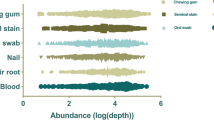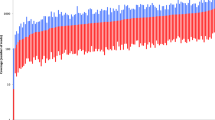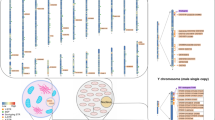Abstract
The ForenSeq™ FGx System (Illumina, San Diego, CA) was initially evaluated in concordance with SWGDAM guidelines for internal validation to determine the quality of the system’s components: the ForenSeq™ DNA Signature Prep Kit reagents, the MiSeq FGx™ instrument, and the ForenSeq™ Universal Analysis Software, for the analysis of targeted, forensically informative single nucleotide polymorphisms (SNPs) and short tandem repeats (STRs). This multiplex consisted of STRs (autosomal, X, and Y) and SNPs (identity, ancestry, and phenotypic) that were run using one preparation process. Overall, the ForenSeq™ FGx System performed as well as the traditional capillary electrophoresis-based method in producing usable profile information, along with additional information that could aid in investigative leads. The MiSeq FGx™ System was validated using DNA samples in studies testing reproducibility, repeatability, concordance, sensitivity, and mock case single donor samples. Overall, genotyping results for STRs and SNPs were concordant with the profiles generated from conventional STR analysis using Identifiler and SNPs typed by 23andMe analysis. Genotypes of the ForenSeq™ aSNPs were used to evaluate biogeographical ancestry estimations using ForenSeq™ Universal Analysis Software, FROG-kb database (KIDD aiSNP 55 panel), and 23andMe. The system was shown to provide reproducible genotypes and reliable results were obtained at levels as low as 50 pg. All mock case samples were concordant with the donor profile. The results support consideration of the ForenSeq™ FGx System as an acceptable alternative to current STR and SNP analysis, pending formal developmental and internal validation studies.






Similar content being viewed by others

References
Budowle B et al (1995) Simple protocols for typing forensic biological evidence: chemiluminescent detection for human DNA quantitation and restriction fragment length polymorphism (RELP) analyses and manual typing of polymerase chain reaction (PCR) amplified polymorphisms. Electrophoresis 16(1):1559–1567
Giusti AM et al (1995) Validation and population studies of the loci LDLR, GYPA, HBGG, D7S8, and Gc (PM loci), and HLA-DQα using a multiplex amplification and typing procedure. J Forensic Sci 40(1):45–54
Baumstark AL et al (1993) PCR amplification and typing of the HLA DQα gene in forensic samples. J Forensic Sci 38(2):239–249
Fregeau CJ, Fourney RM (1993) DNA typing with fluorescently tagged short tandem repeats: a sensitive and accurate approach to human identification. Biotechniques 15(1):100–119
Moretti TR et al (2001) Validation of short tandem repeats (STRs) for forensic usage: performance testing of fluorescent multiplex STR systems and analysis of authentic and simulated forensic samples. J Forensic Sci 46(3):647–660
Budowle B, van Daal A (2008) Forensically relevant SNP classes. Biotechniques 44(5):603–8. doi:10.2144/000112806, 610
Nievergelt CM, Maihofer AX, Shekhtman T et al (2013) Inference of human continental origin and admixture proportions using a highly discriminative ancestry informative 41-SNP panel. Investig Genet 4(1):13. doi:10.1186/2041-2223-4-13
Peter Claes, Denise K. Liberton, Katleen Daniels, Kerri Matthes Rosana, Ellen E. Quillen, Laurel N. Pearson, Brian McEvoy, Marc Bauchet, Arslan A. Zaidi, Wei Yao, Hua Tang, Gregory S. Barsh, Devin M. Absher, David A. Puts, Jorge Rocha, Sandra Beleza, Rina and MDS (2013) Modeling 3D Facial Shape from DNA. PLoS Genet. Rev
Gettings KB et al (2014) A 50-SNP assay for biogeographic ancestry and phenotype prediction in the US population. Forensic Sci Int Genet 8(1):101–108
Walsh S, Lindenbergh A, Zuniga SB et al (2011) Developmental validation of the IrisPlex system: determination of blue and brown iris colour for forensic intelligence. Forensic Sci Int Genet 5(5):464–71. doi:10.1016/j.fsigen.2010.09.008
Walsh S, Liu F, Ballantyne KN, van Oven M, Lao O, Kayser M (2011) IrisPlex: a sensitive DNA tool for accurate prediction of blue and brown eye colour in the absence of ancestry information. Forensic Sci Int Genet 5(3):170–80. doi:10.1016/j.fsigen.2010.02.004
Walsh S, Liu F, Wollstein A et al (2013) The HIrisPlex system for simultaneous prediction of hair and eye colour from DNA. Forensic Sci Int Genet 7:98–115
Draus-Barini J, Walsh S, Pośpiech E et al (2013) Bona fide colour: DNA prediction of human eye and hair colour from ancient and contemporary skeletal remains. Investig Genet 4(1):3. doi:10.1186/2041-2223-4-3
Liu F, van Duijn K, Vingerling JR et al (2009) Eye color and the prediction of complex phenotypes from genotypes. Curr Biol 19(5):R192–3. doi:10.1016/j.cub.2009.01.027
Rajeevan H, Soundararajan U, Pakstis AJ, Kidd KK (2012) Introducing the forensic research/reference on genetics knowledge base, FROG-kb. Investig Genet 3(1):18. doi:10.1186/2041-2223-3-18
Pati N, Schowinsky V, Kokanovic O, Magnuson V, Ghosh S (2004) A comparison between SNaPshot, pyrosequencing, and biplex invader SNP genotyping methods: accuracy, cost, and throughput. J Biochem Biophys Methods 60(1):1–12. doi:10.1016/j.jbbm.2003.11.005
Bornman DM et al (2012) Short-read, high-throughput sequencing technology for STR genotyping. Biotech Rapid Dispatches 2012:1
Børsting C, Morling N (2015) Next generation sequencing and its applications in forensic genetics. Forensic Sci Int Genet 18:78–89
Daniel R et al (2015) A SNaPshot of next generation sequencing for forensic SNP analysis. Forensic Sci Int Genet 14:50–60
Illumina (2015) Retrieved May 2, 2015, from http://applications.illumina.com/applications/forensics.html
Churchill JD et al (2016) Evaluation of the Illumina® Beta Version ForenSeq™ DNA Signature Prep Kit for use in genetic profiling. Forensic Sci Int Genet 20:20–29
Iozzi S et al (2015) Forensic genetics in NGS era: new frontiers for massively parallel typing. Forensic Sci Int Genet Suppl Ser 5:e418–e419
SWGDAM (December 2012) Retrieved May 2, 2015, from http://swgdam.org/SWGDAM_Validation_Guidelines_APPROVED_Dec_2012.pdf
ForenSeq™ DNA Signature Prep Guide (2015, February 1) Retrieved April 29, 2015, from http://support.illumina.com/content/dam/illumina-support/documents/documentation/chemistry_documentation/forenseq/forenseq-dna-signature-prep-guide-15049528-01.pdf
MiSeq FGx™ Instrument Reference Guide (2015, February 1) Retrieved June 4, 2015, from http://support.illumina.com/content/dam/illumina-support/documents/documentation/system_documentation/miseq-fgx/miseq-fgx-instrument-ref-guide-15050524-c.pdf
ForenSeq™ Universal Analysis Software Guide (2015, February 1) Retrieved April 29, 2015, from http://support.illumina.com/content/dam/illumina-support/documents/documentation/software_documentation/forenseq-universal-analysis-software/forenseq-universal-analysis-software-guide-15053876-c.pdf
SWGDAM interpretation guidelines for autosomal STR typing by forensic DNA testing laboratories, Approved on 14 January 2010
23andMe—how does it work? (2015) Retrieved April 29, 2015, from https://www.23andme.com/howitworks/
Zaiontz, C (2014) Cronbach’s Alpha. Retrieved May 2, 2015, from http://www.real-statistics.com/reliability/cronbachs-alpha/
Budowle B, Shea B, Niezgoda S, Chakraborty R (2001) CODIS STR loci data from 41 sample populations. J Forensic Sci 46(3):453–489
Funes‐Huacca ME et al (2011) A comparison of the effects of PCR inhibition in quantitative PCR and forensic STR analysis. Electrophoresis 32(9):1084–1089
Kidd, K. (2015). FROGkb. Retrieved April 29, 2015, from http://frog.med.yale.edu/FrogKB/
Ancestry composition: 23andMe’s state-of-the-art geographic ancestry analysis. (2014, May 29). Retrieved April 29, 2015, from https://www.23andme.com/ancestry_composition_guide/
The 1000 Genomes Project (2012) Retrieved May 5, 2015, from http://www.1000genomes.org/about
Acknowledgments
The authors wish to thank Carey Davis, Joe Valaro, Cydne Holt, Dan Gheba, and Steven Lee along with the many scientists and corporate leaders from Illumina for their support and suggestions on project design, providing the instrument, and providing the reagents. We would also like to thank the Forensic Science Department at the Pennsylvania State University and the many participants who provided samples for the study. Finally, we thank the reviewers of this manuscript for their thoughtful comments and suggestions. The views and opinions expressed are those of the authors and may not reflect the views of the Pennsylvania State University.
Author information
Authors and Affiliations
Corresponding author
Ethics declarations
Informed consent was obtained from all individual participants included in the study.
All procedures performed in studies involving human participants were in accordance with the ethical standards of the institutional and/or national research committee and with the 1964 Helsinki declaration and its later amendments or comparable ethical standards.
Electronic supplementary material
Below is the link to the electronic supplementary material.
ESM 1
(DOCX 305 kb)
Rights and permissions
About this article
Cite this article
Silvia, A.L., Shugarts, N. & Smith, J. A preliminary assessment of the ForenSeq™ FGx System: next generation sequencing of an STR and SNP multiplex. Int J Legal Med 131, 73–86 (2017). https://doi.org/10.1007/s00414-016-1457-6
Received:
Accepted:
Published:
Issue Date:
DOI: https://doi.org/10.1007/s00414-016-1457-6



